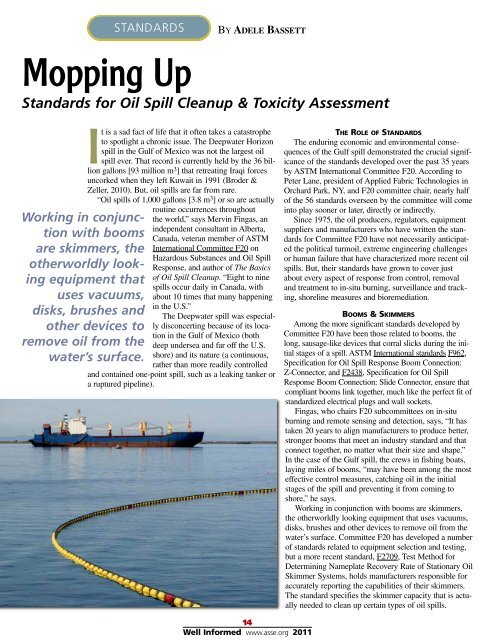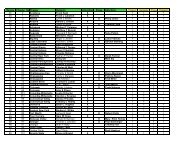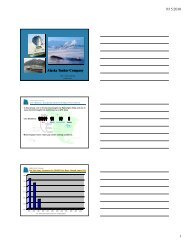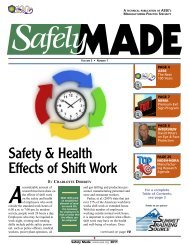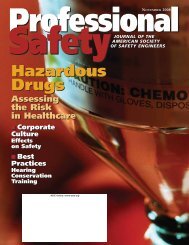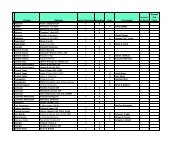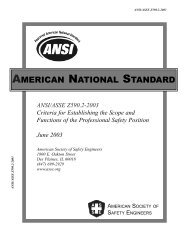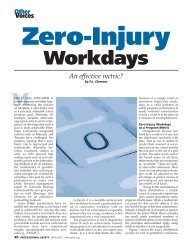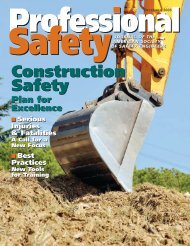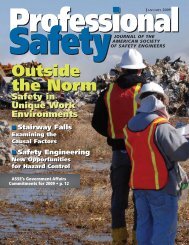STANDARDSBY ADELE B<strong>ASSE</strong>TTMopping UpStandards for Oil Spill Cleanup & Toxicity AssessmentWorking in conjunctionwith boomsare skimmers, theotherworldly lookingequipment thatuses vacuums,disks, brushes andother devices toremove oil from thewater’s surface.It is a sad fact of life that it often takes a catastropheto spotlight a chronic issue. The Deepwater Horizonspill in the Gulf of Mexico was not the largest oilspill ever. That record is currently held by the 36 billiongallons [93 million m 3 ] that retreating Iraqi forcesuncorked when they left Kuwait in 1991 (Broder &Zeller, 2010). But, oil spills are far from rare.“Oil spills of 1,000 gallons [3.8 m 3 ] or so are actuallyroutine occurrences throughoutthe world,” says Mervin Fingas, anindependent consultant in Alberta,Canada, veteran member of ASTMInternational Committee F20 onHazardous Substances and Oil SpillResponse, and author of The Basicsof Oil Spill Cleanup. “Eight to ninespills occur daily in Canada, withabout 10 times that many happeningin the U.S.”The Deepwater spill was especiallydisconcerting because of its locationin the Gulf of Mexico (bothdeep undersea and far off the U.S.shore) and its nature (a continuous,rather than more readily controlledand contained one-point spill, such as a leaking tanker ora ruptured pipeline).THE ROLE OF STANDARDSThe enduring economic and environmental consequencesof the Gulf spill demonstrated the crucial significanceof the standards developed over the past 35 yearsby ASTM International Committee F20. According toPeter Lane, president of Applied Fabric Technologies inOrchard Park, NY, and F20 committee chair, nearly halfof the 56 standards overseen by the committee will comeinto play sooner or later, directly or indirectly.Since 1975, the oil producers, regulators, equipmentsuppliers and manufacturers who have written the standardsfor Committee F20 have not necessarily anticipatedthe political turmoil, extreme engineering challengesor human failure that have characterized more recent oilspills. But, their standards have grown to cover justabout every aspect of response from control, removaland treatment to in-situ burning, surveillance and tracking,shoreline measures and bioremediation.BOOMS &SKIMMERSAmong the more significant standards developed byCommittee F20 have been those related to booms, thelong, sausage-like devices that corral slicks during the initialstages of a spill. ASTM International standards F962,Specification for Oil Spill Response Boom Connection:Z-Connector, and F2438, Specification for Oil SpillResponse Boom Connection: Slide Connector, ensure thatcompliant booms link together, much like the perfect fit ofstandardized electrical plugs and wall sockets.Fingas, who chairs F20 subcommittees on in-situburning and remote sensing and detection, says, “It hastaken 20 years to align manufacturers to produce better,stronger booms that meet an industry standard and thatconnect together, no matter what their size and shape.”In the case of the Gulf spill, the crews in fishing boats,laying miles of booms, “may have been among the mosteffective control measures, catching oil in the initialstages of the spill and preventing it from coming toshore,” he says.Working in conjunction with booms are skimmers,the otherworldly looking equipment that uses vacuums,disks, brushes and other devices to remove oil from thewater’s surface. Committee F20 has developed a numberof standards related to equipment selection and testing,but a more recent standard, F2709, Test Method forDetermining Nameplate Recovery Rate of Stationary OilSkimmer Systems, holds manufacturers responsible foraccurately reporting the capabilities of their skimmers.The standard specifies the skimmer capacity that is actuallyneeded to clean up certain types of oil spills.14Well Informed www.asse.org 2011
DSTANDARDASTMCommitteeE47“Mechanical means of combating an oil spill—booms, skimmers and temporary storage facilities—canbe effective, weather permitting and provided they areoperated continuously,” explains Crickard.IN-SITU BURNINGThe Deepwater Horizon spill required other measuresduring initial response. In-situ burning involves corrallingconcentrated areas of oil within fireproof booms,moving the collected oil away from other cleanup operationsand setting fire to it. Early on, the U.S. CoastGuard conducted a series of small in-situ burns, clearingthe Gulf’s surface of some of the oil.“Previously, there were a lot of myths about what insituburning could accomplish,” says Fingas. ASTMF2152, Guide for In-Situ Burning of Spilled Oil: Fire-<strong>Resistant</strong> Boom, “was a landmark ASTM standard,where the standard was actually developed in conjunctionwith the creation and testing of an improved fireresistantboom.” The U.S. Coast Guard, U.S. MineralsManagement Service and Environment Canada, amongother groups, worked together, setting up a series of testbasins in Mobile, AL, to develop a superior productand ASTM International standards. Committee F20 isalso responsible for F1788, Guide for In-Situ Burning ofOil Spills on Water: Environmental and OperationalConsiderations. F1788 is designed to aid decision makersand spill responders in contingency planning, spillresponse and training.DISPERSANTSDispersants are yet another surface control measure;they are super-strength detergents, usually sprayed ontooil slicks from airplanes. Dispersants break down oilslicks into tiny droplets that are driven into the water columnand almost instantly turn into a cloud with morevolume than the initial slick. The cloud eventually disappearsas it is picked up by currents and dispersed into thevastness of the ocean. Over time, sunlight and microorganismsbiodegrade the oil. But, for dispersants to beeffective, conditions must be right—fresh and thick oil,plus some wave agitation to mix the oil and water.“Most oils are initially dispersible,” explains StevePotter, vice president of SL Ross Environmental ResearchLtd., Ontario, Canada. “The more they weatherand the more viscous they become, the more difficult itis for dispersants to act effectively.”According to Lane, the Deepwater Horizon spill triggeredone of the “first large-scale uses of dispersants,”certainly one of the first in the U.S.“ASTM has had a minor influence on the developmentof dispersants in that we have helped get rid ofbad concepts and helped design delivery systems,” saysFingas. For example, among other standards dealingwith dispersants is ASTM F1413, Guide for Oil SpillDispersant Application Equipment: Boom and NozzleSystems.SURVEILLANCE &TRACKINGWith the Deepwater Horizon slick at one point measuringmore than 80 miles [130 km] wide and more than140 miles [230 km] long, surveillance and tracking hasbeen especially crucial because what sometimes appearsto be a slick might not be (Mufson & Achenbach, 2010).“You have cloud shadows, features on the bottomand organic materials that can mimic oil,” says Lane,explaining the challenges of reporting and tracking spills.Also, adds Potter, “It is crucial that the parties involvedspeak the same language during large incidents.”That is where ASTM F1779, Practice for ReportingVisual Observations of Oil on Water, had come into play.“I had been e-mailing friends working at the spill, andthat standard was definitely used,” says Fingas. CommitteeF20 is also responsible for F2534, Guide forVisually Estimating Oil Spill Thickness on Water.SHORELINE MEASURES &BIOREMEDIATIONLater-stage response measures kick into action as oilspills spread. In heavier concentrations, oil can have atoxic, smothering effect. Depending on the situation, it issometimes effective to reduce concentration by addingnutrients or fertilizers. For wildlife, though, ingesting oil,while attempting to clean soiled fur or feathers, amountsto a death sentence.As oil hits land, says Crickard, “Cleanup operationsbecome very labor intensive, primarily using workerswith buckets and shovels to scoop oily mousse (brownwater emulsified oil) into trash bags.”ASTM F2464, Guide for Cleaning of Various OiledShorelines and Habitats, provides techniques for addressingand documenting shoreline cleanup activities in asystematic and consistent way.“The areas under greatest near-term threat from theDeepwater Horizon spill were marshes and delta forms,”says Potter. “If an area is lightly oiled, sometimes theproper choice is to not undertake a cleanup because itwill create more harm than good. If the area is heavilyoiled, you might use water streams to flush it and skimmersto pick up the oil.” In some cases, he says, the bestchoice is burning, a technique addressed by ASTMF2823, Guide for In-Situ Burning of Oil Spills inMarshes. “It may seem like a repugnant choice, but wetlandswill recover from that,” Potter says.Additionally, there are Committee F20 standardsrelated to bioremediation, which rely on oil-eatingmicrobes. Right now those standards are “very elementary,”according to Fingas. “They provide language andconcepts but little protocol for carrying out bioremediationtechniques.”ADSORBENTSAdsorbents are used in the final stages of an oil spillcleanup. Generally made from plastics, they pick upoil coming onto shore or, “as the paper towel of the oilspill business, provide the final polish,” says Fingas.15Well Informed www.asse.org 2011


